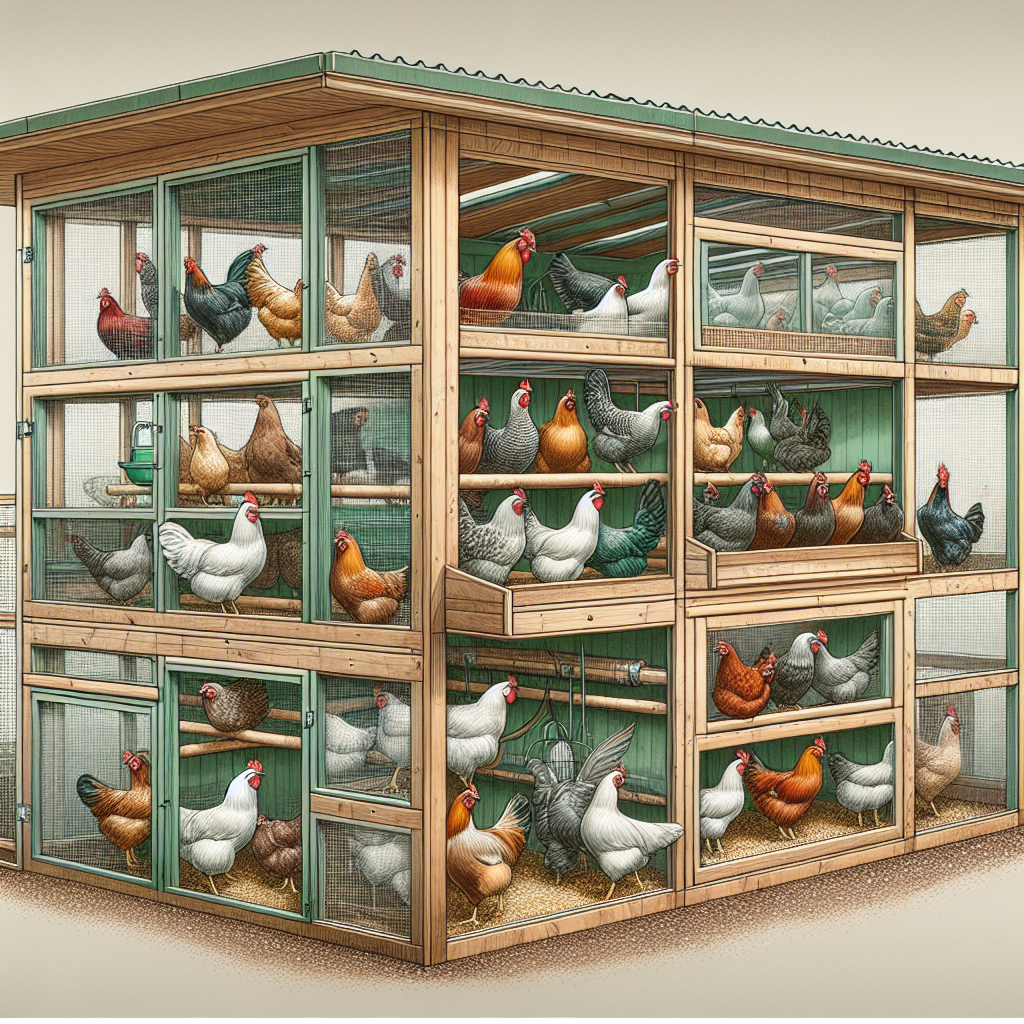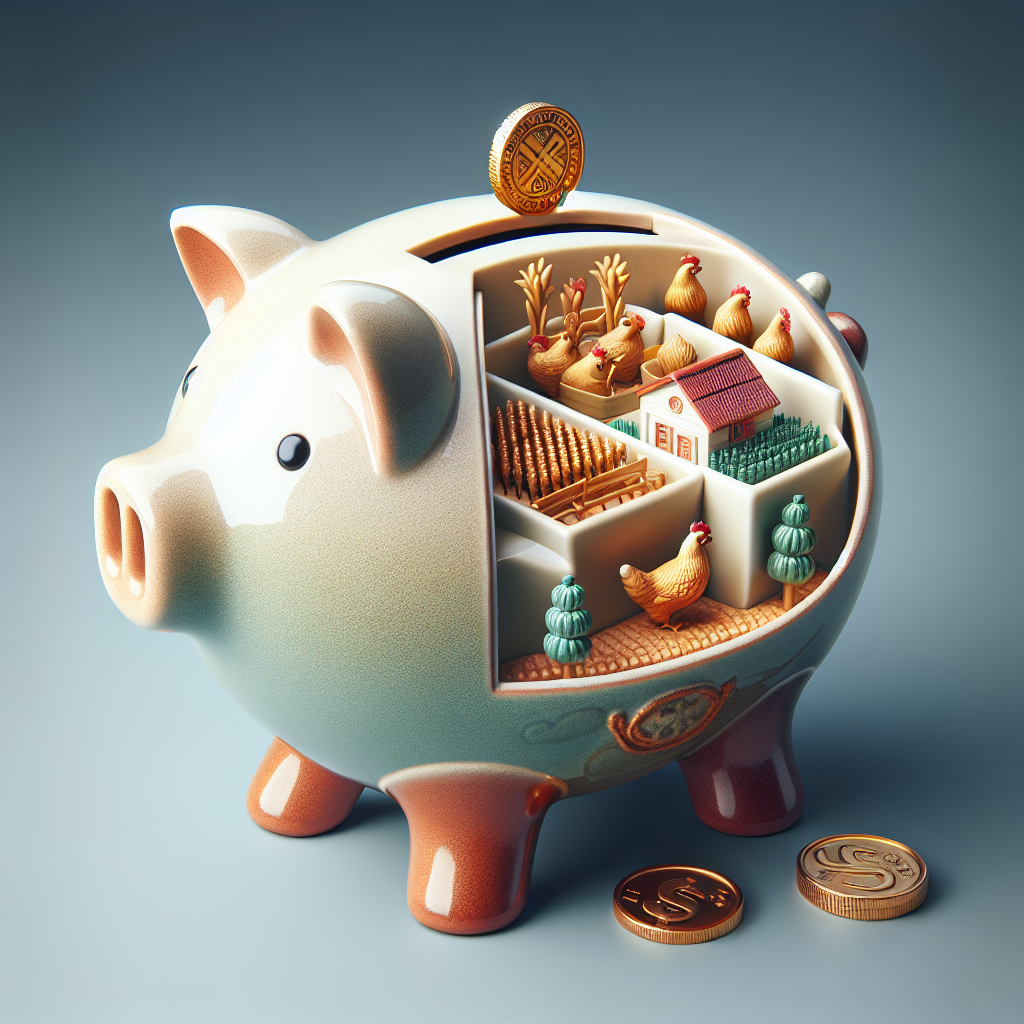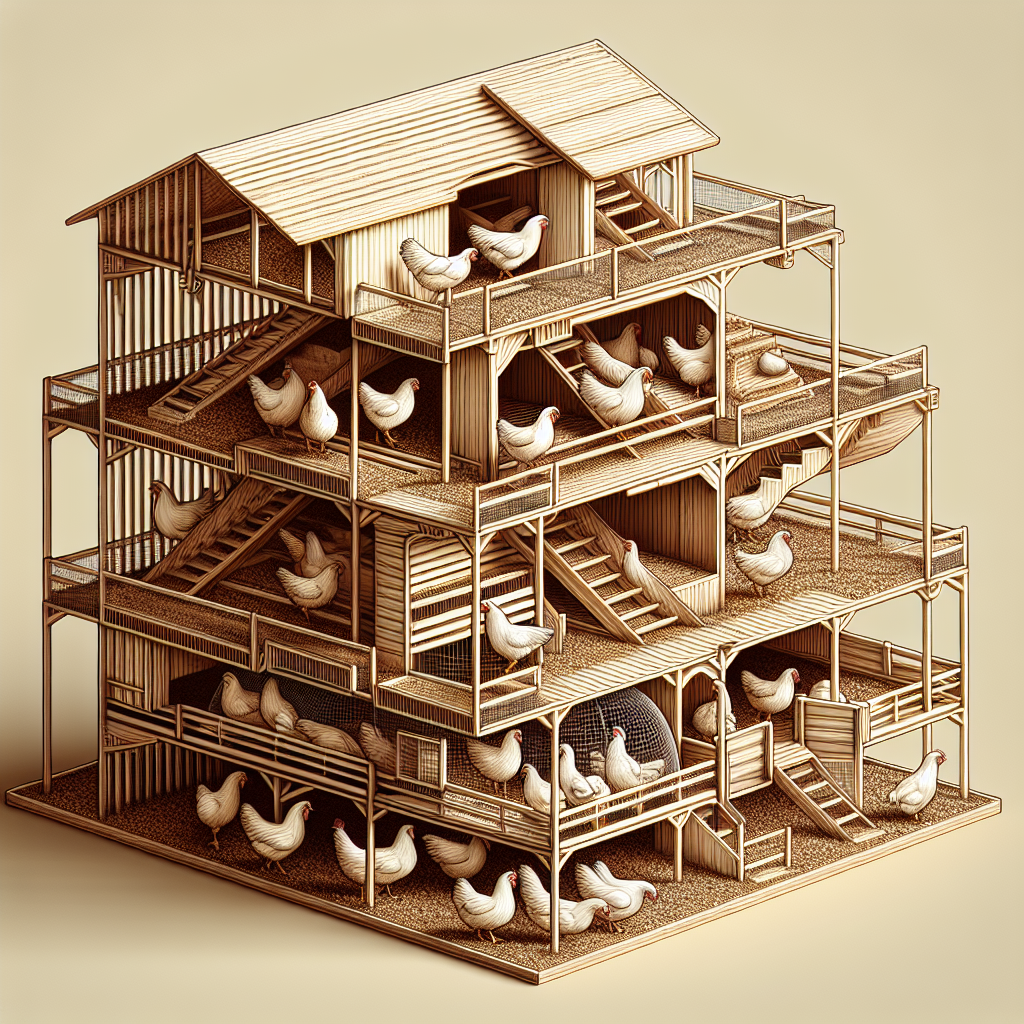Imagine a world where technology and automation work together harmoniously to create efficient and innovative solutions for modern coop designs. Picture the convenience of automated feeding and watering systems, the precision of temperature and climate control, and the seamless monitoring of poultry health. By integrating technology and automation, modern coop designs offer numerous benefits that not only improve productivity and profitability but also enhance the overall well-being of the hens. In this article, we will explore the advantages of embracing technology and automation in the world of poultry farming.
Improved Efficiency and Productivity
Streamlined processes
Integrating technology or automation in modern coop designs offers numerous advantages, including improved efficiency and productivity. One major benefit is the ability to streamline processes. By automating tasks such as feeding, watering, and waste disposal, you can eliminate the need for manual labor and save a significant amount of time. This means that you and your team can focus on other important aspects of managing the coop, ultimately increasing overall productivity.
Faster and more accurate data analysis
Another advantage of technology integration is the ability to analyze data quickly and accurately. With automated monitoring systems in place, you can collect real-time data on factors such as temperature, humidity, and animal health. By having access to this information, you can make data-driven decisions and take immediate action if any issues or abnormalities arise. This not only saves time and effort but also ensures that you can address any potential problems promptly, leading to better overall efficiency.
Reduction in human errors
Integrating technology or automation in modern coop designs can also greatly reduce the occurrence of human errors. Manual tasks in traditional coop setups are susceptible to mistakes, whether it be a miscalculation in feed quantities or forgetting to turn off lights at night. However, with automated systems in place, the chances of errors are significantly minimized. The technology can ensure that tasks are carried out consistently and accurately, leading to more efficient operations and improved productivity.
Enhanced Monitoring and Control
Real-time data monitoring
One of the key advantages of integrating technology or automation in modern coop designs is the ability to monitor data in real-time. Real-time data monitoring allows you to keep track of essential metrics such as temperature, ventilation, and water consumption. By having instant access to this information, you can quickly identify any potential issues or deviations from desired parameters. This ensures that you can address any problems promptly, leading to better control and overall improved conditions for your animals.
Remote control capabilities
With technology integration, you can also enjoy the convenience of remote control capabilities. This means that you can monitor and control various aspects of the coop’s operations from anywhere, at any time. Whether you’re at the office, at home, or even on vacation, you can utilize remote access to check on the coop’s status, adjust settings, or receive real-time alerts. This enhances monitoring and control, allowing you to stay connected and actively manage your coop, even when you’re not physically present on-site.
Alerts and notifications
Integrating technology or automation in modern coop designs also provides the advantage of receiving alerts and notifications. With automated monitoring systems in place, you can set up customized alerts that notify you of any critical changes or events in real-time. For example, you can receive immediate notifications if the temperature in the coop exceeds a safe range or if there is a sudden decrease in water supply. These alerts enable you to take prompt action, preventing potential problems and ensuring the well-being of your animals.
Optimized Resource Utilization
Automated feed and water management
One significant advantage of integrating technology or automation in modern coop designs is the automation of feed and water management. Automated systems can accurately dispense the required amounts of feed and water at scheduled intervals, eliminating the need for manual measurement and delivery. This not only saves time and effort but also ensures that your animals receive consistent and appropriate nutrition. By optimizing feed and water utilization, you can improve the overall health and productivity of your livestock.
Energy-efficient systems
Technology integration in modern coop designs can also lead to the implementation of energy-efficient systems. Utilizing energy-efficient lighting, heating, and ventilation systems can significantly reduce energy consumption and associated costs. Automated controls can regulate temperature and lighting levels based on predetermined settings and real-time data, ensuring optimal conditions for your animals while minimizing energy wastage. This not only benefits your financial bottom line but also demonstrates a commitment to sustainability and environmental stewardship.
Optimal use of space
Integrating technology or automation in modern coop designs allows for optimal use of space. Automated systems can be designed to maximize space utilization, whether it’s through efficient layout planning or by incorporating vertical farming techniques. By utilizing space effectively, you can potentially increase your livestock capacity without the need for significant expansion. This allows for greater scalability and flexibility, accommodating future growth and adapting to changing market demands.
Cost Savings
Reduced labor costs
One of the most prominent advantages of integrating technology or automation in modern coop designs is the potential for significant cost savings. By automating various labor-intensive tasks, you can reduce the need for manual labor, ultimately leading to decreased labor costs. Automated systems can handle duties such as feeding, watering, and waste management, freeing up your time and resources for other essential activities. This not only saves money but also allows you to allocate your workforce more efficiently, maximizing their skills in areas where they can make the most impact.
Lower utility expenses
Integrating technology or automation in modern coop designs can also result in lower utility expenses. Energy-efficient systems, such as LED lighting and smart climate control, can significantly reduce energy consumption and associated costs. By optimizing resource utilization, such as water and electricity, you can save money and operate more sustainably. Lower utility expenses contribute to improved financial efficiency and can help you achieve long-term cost savings.
Decreased mortality rates
Another cost-saving benefit of technology integration is decreased mortality rates. Automated monitoring systems enable you to closely monitor the health and well-being of your animals. With real-time data on factors such as temperature and humidity, you can quickly identify any potential health issues or stressors that may contribute to higher mortality rates. By taking immediate action and providing prompt care, you can minimize the risk of losses and ensure the long-term profitability of your coop.
Improved Animal Welfare
Enhanced health monitoring
Integrating technology or automation in modern coop designs enables enhanced health monitoring for your animals. Real-time data collection and analysis can provide valuable insights into the health status of your livestock. By monitoring data such as body temperature, feed intake, and activity levels, you can quickly identify any signs of illness or distress. Early detection allows for prompt intervention, reducing suffering and improving overall animal welfare. Additionally, improved health monitoring can lead to early identification of disease outbreaks, enabling faster response and containment measures.
Precise climate control
Technology integration in modern coop designs allows for precise climate control, resulting in improved animal welfare. Automated systems can regulate temperature, humidity, and ventilation levels to create optimal living conditions for your animals. Maintaining consistent and controlled environmental parameters contributes to their comfort and health. Whether it’s ensuring warmth during cold weather or preventing heat stress in hot climates, precise climate control contributes to reducing stress levels and promoting overall animal well-being.
Reduced stress levels
By integrating technology or automation in modern coop designs, you can significantly reduce stress levels for your animals. Automated systems can minimize disruptions and create a more predictable and stable environment. For example, consistent feeding schedules and controlled lighting can help establish routines that reduce stress associated with uncertainty. Additionally, advanced monitoring systems can detect and address potential stressors promptly, such as sudden changes in environmental conditions. By providing a calm and stress-free environment, you contribute to improved animal welfare and support their overall health and productivity.
Flexibility and Scalability
Customizable configurations
Integrating technology or automation in modern coop designs offers the advantage of customizable configurations. Automated systems can be tailored to suit the specific needs and requirements of your operation. Whether it’s the size of your coop, the number of animals, or specific environmental conditions, technology integration allows for flexibility in design and setup. Customizable configurations ensure that your coop operates efficiently and accommodates any unique factors or considerations that may impact your livestock.
Easy integration with existing systems
Another advantage of technology integration is the ease of integration with existing systems. Whether you’re looking to enhance specific aspects of your current setup or completely revamp your coop, modern technology solutions can be seamlessly integrated into your existing infrastructure. This allows you to leverage the benefits of automation without the need for a complete overhaul. Easy integration minimizes disruption to your operations and ensures a smooth transition to a more efficient and productive system.
Ability to accommodate growth
Integrating technology or automation in modern coop designs provides the ability to accommodate growth and scalability. As your business expands or market demands change, automated systems offer the flexibility to adapt and scale accordingly. Whether it’s increasing the capacity of your coop, diversifying your livestock, or adjusting production levels, technology integration ensures that your operations can keep up with evolving needs. The ability to accommodate growth contributes to long-term sustainability and success in the competitive market.
Data-driven Decision Making
Access to comprehensive data
One of the key advantages of integrating technology or automation in modern coop designs is access to comprehensive data. Automated monitoring systems collect a vast amount of real-time data on various parameters and factors that impact your operations. This data provides valuable insights into the performance of your coop, allowing you to make informed decisions based on facts and trends. Having access to comprehensive data enables you to identify areas for improvement, optimize processes, and continuously enhance the efficiency and productivity of your coop.
Analytical tools for informed decisions
In addition to data access, technology integration provides analytical tools that facilitate informed decision making. Advanced software and analytics platforms can process and analyze the collected data, offering valuable insights and visualization. With the help of these tools, you can identify key trends, patterns, and correlations that may not be apparent at first glance. This allows you to make data-driven decisions and implement targeted strategies to improve various aspects of your coop. Analytical tools provide a deeper understanding of your operations and empower you to optimize processes for maximum efficiency and productivity.
Predictive analytics for planning
Integrating technology or automation in modern coop designs also enables the use of predictive analytics for planning purposes. By analyzing historical data and patterns, predictive analytics can forecast future trends and potential outcomes. This allows you to anticipate challenges and opportunities, making proactive decisions and planning ahead. Whether it’s adjusting feed quantities based on growth projections or optimizing resource allocation for peak production periods, predictive analytics provide valuable insights for effective planning and strategic decision making.
Improved Biosecurity
Controlled access and biocontainment
Technology integration in modern coop designs enhances biosecurity measures through controlled access and biocontainment. Automated systems can regulate and monitor access points, ensuring that only authorized personnel or animals enter or exit specified areas. This helps prevent the introduction or spread of diseases, pests, or contaminants. Additionally, advanced monitoring systems can detect anomalies that may indicate a breach or an increased risk of biosecurity threats. By implementing controlled access and biocontainment measures, you can protect the health and well-being of your livestock, minimizing the risk of disease outbreaks and associated losses.
Monitoring and prevention of disease outbreaks
By integrating technology or automation in modern coop designs, you can monitor and prevent disease outbreaks more effectively. Automated systems can continuously monitor various factors and parameters that may contribute to disease prevalence or transmission. For example, real-time monitoring of temperature and humidity can help identify conditions that favor the growth of pathogens. Additionally, automated alerts and notifications can promptly notify you of any suspicious activity or deviations from normal readings. Early detection allows for immediate action and implementation of preventative measures, reducing the risk of disease outbreaks and minimizing losses.
Reduced risk of cross-contamination
Technology integration in modern coop designs also mitigates the risk of cross-contamination between different areas or groups of animals. Automated systems can ensure proper hygiene and sanitation practices, minimizing the transfer of pathogens or contaminants. For example, systematic cleaning and disinfection cycles can be scheduled and automated to prevent cross-contamination between different production cycles. By reducing the risk of cross-contamination, you can maintain high standards of biosecurity and protect the health and well-being of your animals.
Minimized Environmental Impact
Efficient waste management systems
One of the advantages of integrating technology or automation in modern coop designs is the implementation of efficient waste management systems. Automated systems can manage and process waste streams more effectively, reducing the environmental impact. For example, automatic manure collection and treatment systems can optimize the use of resources and minimize the release of pollutants. This not only contributes to environmental sustainability but also ensures compliance with regulations and standards. Efficient waste management systems demonstrate your commitment to sustainable practices and responsible environmental stewardship.
Lower carbon footprint
Integrating technology or automation in modern coop designs can lead to a lower carbon footprint. By optimizing resource utilization, such as energy and water, you can reduce greenhouse gas emissions and energy consumption. Energy-efficient systems, such as LED lighting and advanced climate control, significantly decrease energy requirements and associated carbon emissions. Additionally, by implementing sustainable energy solutions, such as solar power or wind turbines, you can further reduce your reliance on conventional energy sources and decrease your carbon footprint. Lowering your carbon footprint contributes to mitigating climate change and creating a more sustainable future.
Sustainable energy solutions
Technology integration in modern coop designs also enables the adoption of sustainable energy solutions. By utilizing renewable energy sources such as solar panels or wind turbines, you can generate clean and sustainable energy to power your coop’s operations. Sustainable energy solutions not only reduce your environmental impact but also contribute to long-term cost savings. By reducing reliance on traditional energy sources, you can decrease utility expenses and protect your business from the volatility of energy markets. Implementing sustainable energy solutions demonstrates your commitment to environmental responsibility and positions your coop as a leader in sustainable agriculture practices.
Adaptability to Market Demands
Rapid adjustments to production levels
Integrating technology or automation in modern coop designs allows for rapid adjustments to production levels. Automated systems enable quick modifications to feed quantities, lighting schedules, and other crucial factors that impact production. Whether it’s ramping up production to meet increased market demand or scaling down during slower periods, technology integration ensures that you can efficiently respond to market fluctuations. Rapid adjustments to production levels enhance your agility and competitiveness, allowing you to seize opportunities and optimize your resource utilization accordingly.
Integration of market trends
Another advantage of technology integration is the ability to integrate market trends into your coop’s operations. By leveraging data analysis and market insights, you can identify emerging trends and consumer preferences. This information can be utilized to fine-tune your production processes, adapt product offerings, and meet customer demands effectively. Whether it’s adjusting feed formulations to align with current health-conscious preferences or implementing eco-friendly packaging solutions, integrating market trends enables you to stay ahead of the competition and cater to evolving consumer needs.
Quick response to consumer demands
Integrating technology or automation in modern coop designs allows for a quick response to consumer demands. Rapid adjustments to production levels and the ability to customize outputs enable you to flexibly meet the expectations of your customers. Whether it’s producing specialty products or accommodating specific requests, technology integration ensures that you can quickly respond to consumer demands. By providing personalized and timely solutions, you enhance customer satisfaction and strengthen your position in the market.
In conclusion, integrating technology or automation in modern coop designs offers a wide range of advantages. From improved efficiency and productivity to enhanced monitoring and control, the benefits of technology integration are substantial. Optimized resource utilization, cost savings, improved animal welfare, and minimized environmental impact are notable outcomes of technology integration. Furthermore, the adaptability to market demands and the ability to make data-driven decisions contribute to long-term success and competitiveness. By embracing technology, you are not only improving the overall operations of your coop but also positioning yourself as a leader in the industry.




